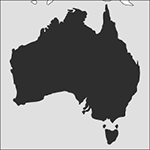
Source: MAPS IN MINUTES™ © RH Publications (1997)
Capital:
Canberra
Area:
7,682,300 sq km (2,966,200 sq miles)
Population:
22,015,576 (2012 est)
Currency:
1 Australian dollar = 100 cents
Religions:
Roman Catholic 25.3%; Anglican 17.1%; other Protestant 11.7%; other Christian 7.1%
Ethnic Groups:
White 92.0%; Asian 7.0%; Aboriginal and other 1.0%
Languages:
English (official); minority and Aboriginal languages
International Organizations:
UN; OECD; Colombo Plan; ANZUS Pact; Secretariat of the Pacific Community; Pacific Islands Forum; Commonwealth; WTO
An island country and continent in the Southern Hemisphere in the south‐west Pacific Ocean. Surrounding it are numerous islands, the largest being Tasmania, and off its east coast lies the Great Barrier Reef.
Physical
Much of the continent has a hot, dry climate, and a large part of the central area is desert or semi‐desert; the most fertile areas are on the eastern coastal plains and in the south‐west corner of Western Australia.
Economy
Australia’s economy is based on mining, agriculture, and industry. Agricultural land, which is periodically devastated by drought, accounts for 64% of Australia’s territory, almost all of this being devoted to cattle and sheep. Australia is a leading world producer and exporter of wool, beef, wheat, coal, iron ore, aluminium, and other metals. Manufacturing industry is aimed principally at domestic markets. There is also a large service sector.
History
Australia was first inhabited by Aborigines thought to have migrated from south‐east Asia 50,000–40,000 years ago. Although the first known European discoveries of the continent were those made in the early 17th century, there may have been earlier Portuguese discoveries. It was visited by an Englishman, William Dampier, in 1688 and 1699. Captain James Cook claimed British possession of the eastern part of the continent in 1770, naming it New South Wales. The British penal colony of New South Wales was founded in 1788. Immigration of free settlers from 1820 onwards aided the colony’s development, as did exploration, which opened pastures for the wool industry. Squatter settlement of much of eastern Australia led to conflict with the Aborigines, resulting in events such as the Myall Creek Massacre (1838). Van Diemen’s Land (from 1855 Tasmania), settled in 1803, became a separate colony in 1825. Moreton Bay, founded as a penal settlement in 1824, became the colony of Queensland in 1859. The colony of Western Australia was founded in 1829. The Port Phillip District, settled illegally in 1834, became the colony of Victoria in 1851. South Australia, founded as a province in 1834, became a crown colony in 1842. All of the colonies except Western Australia were granted responsible government during the 1850s. The gold rushes of the 1850s and 1860s brought many changes. The White Australia Policy can be traced back to that period. Demands for land to be opened for selectors increased. Western Australia, granted responsible government in 1890, developed more slowly than the other colonies. In 1901 the six colonies were federated as self‐governing states to form the Commonwealth of Australia. Powers were distributed between the Commonwealth and state governments, and with the crown through its representative, the governor‐general, retaining (until 1931) overall responsibility for defence and foreign affairs. State legislators would have full responsibility for internal state affairs. Sir Edmund Barton, who had been prominent in the federation movement, was the first Prime Minister. The Northern Territory was transferred from South Australia to the Commonwealth in 1911. In the same year land was transferred to the Commonwealth from New South Wales, for the creation of the Australian Capital Territory, Canberra. (Jervis Bay was added to the Australian Capital Territory in 1915.) The Commonwealth Parliament met in Melbourne until 1927, when it was transferred to Canberra. In the 1930s reserves were established for the Aborigines, and in 1981 the Pitjantjara Aborigines were granted freehold titles to land in Southern Australia. Australia fought with the Allies in both World Wars and with the USA in Vietnam. After World War II ties with Britain diminished, and Australia joined the ANZUS and South‐East Asia Treaty Organization powers. The Labor governments of the 1970s and 1980s, led by Gough Whitlam and Bob Hawke, strengthened trade ties with the non‐communist Far East, but a deteriorating economy in the 1980s led to labour unrest and in 1991 to the replacement of Hawke by his deputy, Paul Keating. In response to increasing support for Australia becoming a republic, Queen Elizabeth II announced (1993) that she would agree to such a constitutional change if the Australian people wanted it. A referendum motion to replace the Queen with a President was defeated in 1999. Following the Labor Party’s heavy electoral defeat by a Liberal‐National Party coalition in 1996, Liberal leader John Howard was appointed Prime Minister; his party was re‐elected in 1998, 2001, and 2004. Australia participated in the 2003 Iraq War and in subsequent military operations until 2009. Labor returned to power in 2007 under Kevin Rudd. Shortly before the 2010 election rivalry within the Labor party led to his replacement by Julia Gillard; however, Rudd regained the leadership in 2013. This infighting contributed to Labor’s defeat in the 2013 election by the Liberal-National Party Coalition under Tony Abbott; other factors were economic problems and an unpopular immigration policy.
Abbott survived a leadership challenge in February 2015 when his popularity plummeted, but was defeated by moderate Malcolm Turnbull in a further challenge in Sept 2015. Turnbull was previously Minister for Communications. Many in his party dislike his support for climate change action and gay marriage. He called an early election in 2016, which he nearly lost to Labor, then led by Bill Shorten. Turnbull resigned from Parliament in August 2018 and was replaced by Scott Morrison, who served as prime minister until May 2022, when he lost the federal election to Labor leader Anthony Albanese. In September 2022, King Charles III became the head of the Commonwealth, following the death of Queen Elizabeth II.